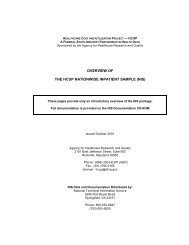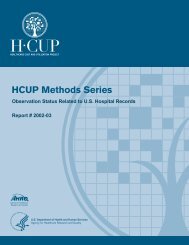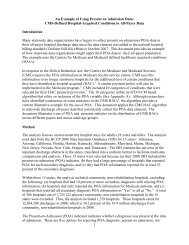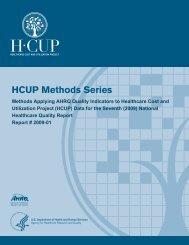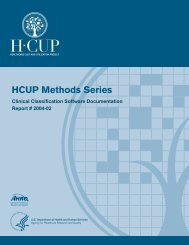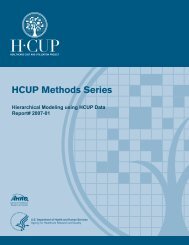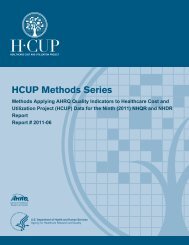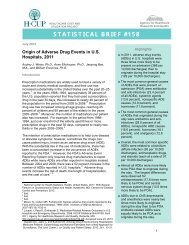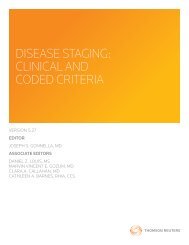Methodological Issues when Studying Readmissions and ... - HCUP
Methodological Issues when Studying Readmissions and ... - HCUP
Methodological Issues when Studying Readmissions and ... - HCUP
Create successful ePaper yourself
Turn your PDF publications into a flip-book with our unique Google optimized e-Paper software.
complicated short-term postoperative course. Fracture type was a strong predictor ofreoperation for ankle fusion or replacement. Hospital volume did not play a significantrole in the rates of short-term or intermediate-term complications.Zhan C, Kaczmarek R, Loyo-Berrios N, et al. Incidence <strong>and</strong> short-term outcomes of primary <strong>and</strong>revision hip replacement in the United States The Journal of Bone <strong>and</strong> Joint Surgery (American)2007;89:526-533.Background: The purpose of this study was to use 2003 nationwide United States datato determine the incidences of primary total hip replacement, partial hip replacement,<strong>and</strong> revision hip replacement <strong>and</strong> to assess the short-term patient outcomes <strong>and</strong> factorsassociated with the outcomes.Methods: We screened more than eight million hospital discharge abstracts from the2003 Healthcare Cost <strong>and</strong> Utilization Project Nationwide Inpatient Sample <strong>and</strong>approximately nine million discharge abstracts from five State Inpatient Databases.Patients who had undergone total, partial, or revision hip replacement were identifiedwith use of International Classification of Diseases, Ninth Revision, Clinical Modification(ICD-9-CM) procedure codes. In-hospital mortality, perioperative complications,readmissions, <strong>and</strong> the association between these outcomes <strong>and</strong> certain patient <strong>and</strong>hospital variables were analyzed.Results: Approximately 200,000 total hip replacements, 100,000 partial hipreplacements, <strong>and</strong> 36,000 revision hip replacements were performed in the UnitedStates in 2003. Approximately 60% of the patients were sixty-five years of age or older<strong>and</strong> at least 75% had one or more comorbid diseases. The in-hospital mortality ratesassociated with these three procedures were 0.33%, 3.04%, <strong>and</strong> 0.84%, respectively.The perioperative complication rates associated with the three procedures were 0.68%,1.36%, <strong>and</strong> 1.08%, respectively, for deep vein thrombosis or pulmonary embolism;0.28%, 1.88%, <strong>and</strong> 1.27% for decubitus ulcer; <strong>and</strong> 0.05%, 0.06%, <strong>and</strong> 0.25% forpostoperative infection. The rates of readmission, for any cause, within thirty days were4.91%, 12.15%, <strong>and</strong> 8.48%, respectively, <strong>and</strong> the rates of readmissions, within thirtydays, that resulted in a surgical procedure on the affected hip were 0.79%, 0.91%, <strong>and</strong>1.53%. The rates of readmission, for any cause, within ninety days were 8.94%, 21.14%,<strong>and</strong> 15.72%, <strong>and</strong> the rates of readmissions, within ninety days, that resulted in a surgicalprocedure on the affected hip were 2.15%, 1.61%, <strong>and</strong> 3.99%. Advanced age <strong>and</strong>comorbid diseases were associated with worse outcomes, while private insurancecoverage <strong>and</strong> planned admissions were associated with better outcomes. No consistentassociation between outcomes <strong>and</strong> hospital characteristics, such as hip procedurevolume, was identified.Conclusions: Total hip replacement, partial hip replacement, <strong>and</strong> revision hipreplacement are associated with different rates of postoperative complications <strong>and</strong>readmissions. Advanced age, comorbidities, <strong>and</strong> non-elective admissions are associatedwith inferior outcomes.<strong>HCUP</strong> (02/25/11)C-12Method Series on Readmission <strong>and</strong> Revisit Analyses



